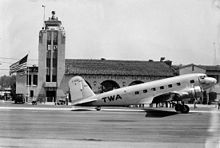- Douglas DC-1
-
DC-1 Douglas DC-1 on its hand over to TWA in December 1933 Role Prototype and Testbed Manufacturer Douglas Aircraft Company First flight July 1, 1933 Introduction December 1933 Primary user Transcontinental & Western Air Number built 1 Developed into Douglas DC-2 The Douglas DC-1 was the first model of the famous United States DC (Douglas Commercial) commercial transport aircraft series. Although only one example of the DC-1 was produced, the design was the basis for the DC-2 and DC-3.
Contents
Design and development
Development of the DC-1 can be traced back to the 1931 crash of TWA Flight 599, which had suffered a structural failure of one of its wings, probably due to water which had over time seeped between the layers of the wood laminate and dissolved the glue holding the layers together. Following the accident, the Aeronautics Branch of the US Department of Commerce placed stringent restrictions on the use of wooden wings on passenger airliners.[1][2] Boeing developed an answer, the 247, a twin engined all-metal monoplane with a retractable undercarriage, but their production capacity was reserved to meet the needs of United Airlines, part of United Aircraft and Transport Corporation that also owned Boeing. TWA needed a similar aircraft to respond to the competition from the high-performance Boeing 247 and asked five manufacturers to bid for construction of a three-engine, 12-seat aircraft of all-metal construction, capable of flying 1,080 mi (1,740 km) at 150 mph (242 km/h). The most demanding part of the specification was that the airliner would have to be capable of safely taking off from any airport on TWA's main routes (and in particular Albuquerque, at high altitude and with severe summer temperatures) with an engine failed.[3][4]
Donald Douglas was initially reluctant to participate in the invitation from TWA. He doubted there would be a market for 100 aircraft, the number of sales necessary to cover development costs. Nevertheless, he submitted a design consisting of an all-metal, low-wing, twin-engine aircraft seating 12 passengers, a crew of two and a flight attendant. The aircraft exceeded the specifications of TWA even with two engines. It was insulated against noise, heated, and fully capable of both flying and performing a controlled takeoff or landing on one engine.
Don Douglas stated in a 1935 article on the DC-2 that the first DC-1 cost $325,000 dollars to design and build.[5]
Operational history
Only one aircraft was produced, the prototype made its maiden flight on July 1, 1933,[6] flown by Carl Cover. It was given the model name DC-1. During a half year of testing, it performed more than 200 test flights and demonstrated its superiority versus the most used airliners at that time, the Ford and Fokker Trimotors. It was flown across the United States, making the journey in a record time of 13 hours 5 minutes.
TWA accepted the aircraft on 15 September 1933 with a few modifications (mainly increasing seating to 14 passengers and adding more powerful engines) and ordered 20 examples of the developed production model was called the Douglas DC-2.[7]
The DC-1 was sold to Lord Forbes in the United Kingdom in May 1938, who operated it for a few months before selling it in France in October 1938. It was then sold to Líneas Aéreas Postales Españolas (L.A.P.E.) in Spain in November 1938 and was used by the Spanish Republican Air Force as a transport aircraft.[8] Later operated by Iberia Airlines from July 1939 with the name Negron it force-landed at Malaga, Spain in December 1940 and was damaged beyond repair.[7]
Specifications (DC-1)
Data from McDonnell Douglas Aircraft since 1920[9]
General characteristics
- Crew: 2 pilots
- Capacity: 12 passengers
- Length: 60 ft 0 in (18.29 m)
- Wingspan: 85 ft 0 in (25.91 m)
- Height: 16 ft 0 in (4.88 m)
- Wing area: 942 sq ft (87.5 m²)
- Empty weight: 11,780 lb (5,343 kg)
- Loaded weight: 17,500 lb (7,938 kg)
- Powerplant: 2 × Wright Cyclone SGR-1820F3 9-cylinder radial engines, 710 hp (530 kW) each
Performance
- Maximum speed: 210 mph (183 knots, 338 km/h)
- Cruise speed: 190 mph (165 knots, 306 km/h) at 8,000 ft (2,440 m)
- Range: 1,000 mi (870 nmi, 1,610 km)
- Service ceiling: 23,000 ft (7,010 m)
See also
- Related development
- Aircraft of comparable role, configuration and era
- Related lists
References
- Notes
- ^ Friedman and Friedman Aeroplane Monthly May 2001, pp. 34–40.
- ^ O'Leary Aeroplane Monthly February 2007, p. 71.
- ^ Francillon 1979, p. 166.
- ^ Pearcy Air Enthusiast 1982, p. 60.
- ^ "Secrets of Speed." Popular Mechanics, February 1935.
- ^ Gradidge 2006, p. 9.
- ^ a b Gradidge 2006, p. 299.
- ^ "Aircraft that took part in the Spanish Civil War." Aircraft of the Spanish Civil War (zi.ku). Retrieved: February 4, 2011.
- ^ Francillon 1979, p. 173.
- Bibliography
- Francillon, René J. McDonnell Douglas Aircraft since 1920. London: Putnam, 1979. ISBN 0-370-00050-1.
- Freidman, Herbert M. and Ada Kera Friedman. "The Legacy of the Rockne Crash". Aeroplane, Vol. 29, No. 5, Issue 337, May 2001, pp. 34–40. London: IPC. ISSN 0143-7240.
- Gradidge, Jennifer M., ed. DC-1, DC-2, DC-3: The First Seventy Years. Tonbridge, Kent, UK: Air-Britain (Historians), Two volumes, 2006. ISBN 0-85130-332-3.
- O'Leary, Michael. "Database: Douglas DC-1 & DC-2". Aeroplane, Vol. 35, No. 2, Issue 406, February 2007, pp. 70–89. London: IPC. ISSN 0143-7240.
- Pearcy, Arthur. "Douglas Commercial Two". Air Enthusiast, Nineteen, August–November 1982, pp. 60–77. Bromley, UK: Fine Scroll. ISSN 0143-5450.
External links
Douglas and McDonnell Douglas airliners Piston-engined Jet-engined Not developed DC-7 (Globemaster) · DC-7D · DC-8 (piston airliner) · DC-9 (Model 2067) · MD-91X/-92X/-94X · MD-12/-XX
Lists relating to aviation General Aircraft (manufacturers) · Aircraft engines (manufacturers) · Airlines (defunct) · Airports · Civil authorities · Museums · Registration prefixes · Rotorcraft (manufacturers) · TimelineMilitary Accidents/incidents Records Categories:- Douglas aircraft
- United States airliners 1930–1939
- Twin-engined aircraft
Wikimedia Foundation. 2010.


